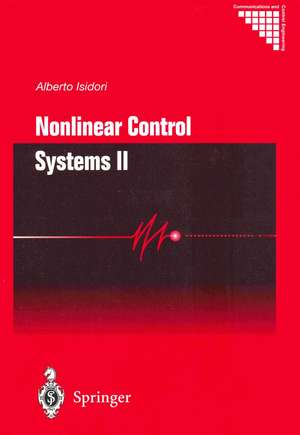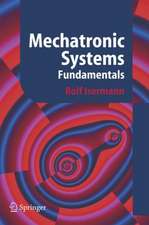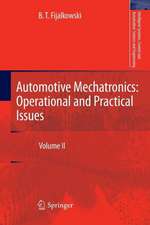Nonlinear Control Systems II: Communications and Control Engineering
Autor Alberto Isidorien Limba Engleză Paperback – 21 oct 2012
| Toate formatele și edițiile | Preț | Express |
|---|---|---|
| Paperback (1) | 1380.78 lei 6-8 săpt. | |
| SPRINGER LONDON – 21 oct 2012 | 1380.78 lei 6-8 săpt. | |
| Hardback (1) | 1387.73 lei 6-8 săpt. | |
| SPRINGER LONDON – 22 sep 1999 | 1387.73 lei 6-8 săpt. |
Din seria Communications and Control Engineering
- 15%
 Preț: 659.70 lei
Preț: 659.70 lei - 20%
 Preț: 879.74 lei
Preț: 879.74 lei - 18%
 Preț: 953.65 lei
Preț: 953.65 lei - 18%
 Preț: 1117.03 lei
Preț: 1117.03 lei - 9%
 Preț: 1385.77 lei
Preț: 1385.77 lei - 18%
 Preț: 1128.08 lei
Preț: 1128.08 lei - 18%
 Preț: 953.65 lei
Preț: 953.65 lei - 15%
 Preț: 656.89 lei
Preț: 656.89 lei - 18%
 Preț: 896.52 lei
Preț: 896.52 lei - 18%
 Preț: 1113.26 lei
Preț: 1113.26 lei - 18%
 Preț: 1388.22 lei
Preț: 1388.22 lei - 15%
 Preț: 647.27 lei
Preț: 647.27 lei - 18%
 Preț: 954.45 lei
Preț: 954.45 lei - 18%
 Preț: 1231.47 lei
Preț: 1231.47 lei - 18%
 Preț: 948.92 lei
Preț: 948.92 lei - 18%
 Preț: 1232.57 lei
Preț: 1232.57 lei - 18%
 Preț: 1127.28 lei
Preț: 1127.28 lei - 15%
 Preț: 643.34 lei
Preț: 643.34 lei - 18%
 Preț: 1401.30 lei
Preț: 1401.30 lei - 15%
 Preț: 651.51 lei
Preț: 651.51 lei - 20%
 Preț: 1454.07 lei
Preț: 1454.07 lei - 18%
 Preț: 948.79 lei
Preț: 948.79 lei - 18%
 Preț: 1233.06 lei
Preț: 1233.06 lei - 18%
 Preț: 947.85 lei
Preț: 947.85 lei - 18%
 Preț: 950.96 lei
Preț: 950.96 lei - 18%
 Preț: 956.99 lei
Preț: 956.99 lei - 15%
 Preț: 644.18 lei
Preț: 644.18 lei - 18%
 Preț: 946.87 lei
Preț: 946.87 lei - 18%
 Preț: 951.14 lei
Preț: 951.14 lei - 18%
 Preț: 961.55 lei
Preț: 961.55 lei - 15%
 Preț: 644.18 lei
Preț: 644.18 lei - 20%
 Preț: 990.80 lei
Preț: 990.80 lei - 18%
 Preț: 1006.72 lei
Preț: 1006.72 lei - 18%
 Preț: 942.44 lei
Preț: 942.44 lei - 18%
 Preț: 1233.06 lei
Preț: 1233.06 lei - 15%
 Preț: 641.85 lei
Preț: 641.85 lei - 18%
 Preț: 957.75 lei
Preț: 957.75 lei - 15%
 Preț: 649.87 lei
Preț: 649.87 lei - 18%
 Preț: 958.07 lei
Preț: 958.07 lei - 18%
 Preț: 1117.99 lei
Preț: 1117.99 lei - 18%
 Preț: 1395.94 lei
Preț: 1395.94 lei - 18%
 Preț: 781.62 lei
Preț: 781.62 lei - 18%
 Preț: 953.20 lei
Preț: 953.20 lei - 18%
 Preț: 1109.78 lei
Preț: 1109.78 lei
Preț: 1380.78 lei
Preț vechi: 1683.87 lei
-18% Nou
Puncte Express: 2071
Preț estimativ în valută:
264.25€ • 274.86$ • 218.15£
264.25€ • 274.86$ • 218.15£
Carte tipărită la comandă
Livrare economică 14-28 aprilie
Preluare comenzi: 021 569.72.76
Specificații
ISBN-13: 9781447111603
ISBN-10: 1447111605
Pagini: 308
Ilustrații: XII, 293 p.
Dimensiuni: 155 x 235 x 16 mm
Greutate: 0.44 kg
Ediția:Softcover reprint of the original 1st ed. 1999
Editura: SPRINGER LONDON
Colecția Springer
Seria Communications and Control Engineering
Locul publicării:London, United Kingdom
ISBN-10: 1447111605
Pagini: 308
Ilustrații: XII, 293 p.
Dimensiuni: 155 x 235 x 16 mm
Greutate: 0.44 kg
Ediția:Softcover reprint of the original 1st ed. 1999
Editura: SPRINGER LONDON
Colecția Springer
Seria Communications and Control Engineering
Locul publicării:London, United Kingdom
Public țintă
ResearchCuprins
10. Stability of Interconnected Nonlinear Systems.- 10.1 Preliminaries.- 10.2 Asymptotic Stability and Small Perturbations.- 10.3 Asymptotic Stability of Cascade-Connected Systems.- 10.4 Input-to-State Stability.- 10.5 Input-to-State Stability of Cascade-Connected Systems.- 10.6 The “Small-Gain” Theorem for Input-to-State Stable Systems.- 10.7 Dissipative Systems.- 10.8 Stability of Interconnected Dissipative Systems.- 10.9 Dissipative Linear Systems.- 11. Feedback Design for Robust Global Stability.- 11.1 Preliminaries.- 11.2 Stabilization via Partial State Feedback: a Special Case.- 11.3 Stabilization via Output Feedback: a Special Case.- 11.4 Stabilization of Systems in Lower Triangular Form.- 11.5 Design for Multi-Input Systems.- 12. Feedback Design for Robust Semiglobal Stability.- 12.1 Achieving Semiglobal and Practical Stability.- 12.2 Semiglobal Stabilization via Partial State Feedback.- 12.3 A Proof of Theorem 9.6.2.- 12.4 Stabilization of Minimum-Phase Systems in Lower-Triangular Form.- 12.5 Stabilization via Output Feedback Without a Separation Principle.- 12.6 Stabilization via Output Feedback of Non-Minimum-Phase Systems.- 12.7 Examples.- 13. Disturbance Attenuation.- 13.1 Robust Stability via Disturbance Attenuation.- 13.2 The Case of Linear Systems.- 13.3 Disturbance Attenuation.- 13.4 Almost Disturbance Decoupling.- 13.5 An Estimate of the Minimal Level of Disturbance Attenuation.- 13.6L2-gain Design for Linear Systems.- 13.7 GlobalL2-gain Design for a Class of Nonlinear Systems.- 14. Stabilization Using Small Inputs.- 14.1 Achieving Global Stability via Small Inputs.- 14.2 Stabilization of Systems in Upper Triangular Form.- 14.3 Stabilization Using Saturation Functions.- 14.4 Applications and Extensions.- Bibliographical Notes.- References.
Recenzii
From the reviews:
According to the Preface: "The purpose of this book is to present a self-contained and coordinated description of several design methods for nonlinear systems, with special emphasis on the problem of achieving stability, globally or on arbitrarily large domains, in the presence of model uncertainties. The book is intended to be a continuation of my earlier book [Nonlinear Control Systems, third edition, Springer, London, 1995]."
This statement provides an indication of the author’s motivation and the emphasis of the presentation. The book provides a careful and detailed treatment of the selected topics.
It should be mentioned that intimate knowledge of Isidori’s earlier book is not a prerequisite for the current book. Some references are made to the earlier book, but only relatively simple notions of relative degree and feedback transformations are used. Although the numbering scheme of the current book indicates a continuation of the earlier book, the topics covered are distinct and the two books can be studied independently.
Chapter 10 (the first chapter of the book) is devoted to the stability analysis of systems that can be viewed as a cascade or feedback interconnection. Basic analysis tools are introduced, including input-to-state stability, small gain theorem, dissipativity and passivity. Chapter 11 describes methods for global robust stabilization of nonlinear systems. Systems modelled by equations in lower-triangular form containing unknown parameters are introduced. Several control design approaches, based on different assumptions, are developed. Chapter 12 is concerned with "semi-global practical stabilizability". The case of output feedback is given considerable attention. In Chapter 13, the small-gain theorem is used to study robust stabilization in the presence of unmodeled dynamics. This leads to nonlinear H-infinity problems. Chapter 15 treats problems of stabilizability subject tocontrol amplitude constraints: several different approaches are developed. The book concludes with useful bibliographical notes and a list of references that the author has personally used in the development of the book.
The book does an excellent job of pulling together results from numerous research publications and presenting them in a reasonably unified form. The emphasis throughout is on the mathematical development, rather than on t he scientific significance of application of the concepts. Proofs are given for all major results, and in some cases several alternate proofs are provided. Many of the topics introduced remain the subject of active research, so that the book is likely to be of great interest to mathematicians, engineers, and scientists who are, or intend to become, active researchers in robust and global/semiglobal stabilization of nonlinear systems.
Mathematical Reviews m (2000) (Reviewer: N. Harris McClamroch)
This book is essential for serious research in nonlinear control, but requires some seriousness of purpose on the part of the reader.
International Journal of Robust and Nonlinear Control 13 (2003) 91 (Reviewer: David L. Elliott)
According to the Preface: "The purpose of this book is to present a self-contained and coordinated description of several design methods for nonlinear systems, with special emphasis on the problem of achieving stability, globally or on arbitrarily large domains, in the presence of model uncertainties. The book is intended to be a continuation of my earlier book [Nonlinear Control Systems, third edition, Springer, London, 1995]."
This statement provides an indication of the author’s motivation and the emphasis of the presentation. The book provides a careful and detailed treatment of the selected topics.
It should be mentioned that intimate knowledge of Isidori’s earlier book is not a prerequisite for the current book. Some references are made to the earlier book, but only relatively simple notions of relative degree and feedback transformations are used. Although the numbering scheme of the current book indicates a continuation of the earlier book, the topics covered are distinct and the two books can be studied independently.
Chapter 10 (the first chapter of the book) is devoted to the stability analysis of systems that can be viewed as a cascade or feedback interconnection. Basic analysis tools are introduced, including input-to-state stability, small gain theorem, dissipativity and passivity. Chapter 11 describes methods for global robust stabilization of nonlinear systems. Systems modelled by equations in lower-triangular form containing unknown parameters are introduced. Several control design approaches, based on different assumptions, are developed. Chapter 12 is concerned with "semi-global practical stabilizability". The case of output feedback is given considerable attention. In Chapter 13, the small-gain theorem is used to study robust stabilization in the presence of unmodeled dynamics. This leads to nonlinear H-infinity problems. Chapter 15 treats problems of stabilizability subject tocontrol amplitude constraints: several different approaches are developed. The book concludes with useful bibliographical notes and a list of references that the author has personally used in the development of the book.
The book does an excellent job of pulling together results from numerous research publications and presenting them in a reasonably unified form. The emphasis throughout is on the mathematical development, rather than on t he scientific significance of application of the concepts. Proofs are given for all major results, and in some cases several alternate proofs are provided. Many of the topics introduced remain the subject of active research, so that the book is likely to be of great interest to mathematicians, engineers, and scientists who are, or intend to become, active researchers in robust and global/semiglobal stabilization of nonlinear systems.
Mathematical Reviews m (2000) (Reviewer: N. Harris McClamroch)
This book is essential for serious research in nonlinear control, but requires some seriousness of purpose on the part of the reader.
International Journal of Robust and Nonlinear Control 13 (2003) 91 (Reviewer: David L. Elliott)
Notă biografică
Alberto Isidori was born in Rapallo, Italy. He graduated in electrical engineering from the University of Rome in 1965. In 1969 he obtained a degree equivalent to a doctorate in automatic control from the University of Rome.
Since 1975, he has been Professor of Automatic Control at the University of Rome "La Sapienza". Since 1989, he has also held a position of rofessor (on a half-time basis) at the Department of Systems Science and Mathematics, Washington University, St. Louis, Missouri. He has held visiting positions at several academic institutions, including the University of Illinois (Urbana, Il.), the University of California (Berkeley, Ca.) and the ETH (Zurich, Switzerland).
His research interests are primarily focused on mathematical control theory and control engineering.
In 1979, Alberto Isidori initiated a research program aimed at the extension of so-called "geometric theory" of multivariable linear systems, pioneered in the early 1970s by various authors,to linear systems. Linear algebra and linear geometric methods were replaced in nonlinear systems by the methods of differential geometry, whose usefulness in the study of controllability, observability, and minimality of nonlinear systems had been demonstrated in the early 70s. The main intuition of Isidori was to use differential geometric methods in the synthesis of feedback laws for nonlinear systems, more or less in the same way as linear geometric methods were used in the synthesis of feedback laws for linear systems. The result of this seminal work was the development of systematic methods addressing outstanding design problems like feedback linearization, noninteracting control, disturbance decoupling, and model matching.
From 1985 to 1990 Isidori's research concentrated on the development of the "nonlinear analogue" of the notion of the "zero" of a transfer function. Taking as a point of departure the "geometric" interpretation of this notion, the concept of nonlinear zero dynamics was introduced, studied, and applied. As a result, it was shown that most of the features of the notion of zeros of the transfer function of a linear system are actually manifestations of more general principles. Remarkable examples of application of this theory consisted in the study and the solution of the nonlinear equivalent of the so-called "servomechanism problem" of linear system theory and in the characterization of the conditions for feedback equivalence to a nonlinear passive system.
Since the 90s, Isidori has focused his research interests on problems of disturbance attenuation and robust stabilization of nonlinear systems.
Professional Activities
-President of the European Union Control Association (1995-1997).
-Member of the IFAC Council (1993-1996).
-President-elect of IFAC (three-year term to begin following IFAC World Congress in Seoul 2008)
-On the Editorial Board of: European Journal of Control (since 1995), Automatica (since 1990), IEEE Transactions on Automatic Control (since 1990), International Journal of Control (since 1990), International Journal of Robust and Nonlinear Control (since 1991), Journal of Mathematical Systems, Estimation and Control (since 1991), Mathematics of Control, Signals and Systems (1987-89), Applied Stochastic Models and Data Analysis (since 1985), Systems and Control Letters (1981-88).
Awards and Honors
-Georgio Quazza Medal of IFAC, for ?pionering and fundamental contributions to the theory of nonlinear control,? 1996.
-Fellow of the Institute of Electrical and Electronic Engineers, for ?fundamental contributions to nonlinear control theory?, 1987.
-Outstanding Paper Award for papers published on IEEE Transactions on Automatic Control, in 1981 and in 1990.
-Outstanding Paper Award a paper published on Automatica in1991.
Selected Publications
Nonlinear Control Systems (3rd edition), Springer Verlag (1995), pp. 1-549.
Topics in Control Theory, with W. Knobloch and D. Flockerzi, Berkhauser (1993), pp. 1-166.
Output Regulation of Uncertain Nonlinear Systems, with C.I. Byrnes and F. Delli Priscoli, Birkhauser (1997), pp. 1-122.
Trends in Control Theory (editor), Springer Verlag (1995), pp. 1-422.
Systems, Models and Feedback (co-editor, with T.J. Tarn), Birkhauser (1992), pp. 1-402.
Since 1975, he has been Professor of Automatic Control at the University of Rome "La Sapienza". Since 1989, he has also held a position of rofessor (on a half-time basis) at the Department of Systems Science and Mathematics, Washington University, St. Louis, Missouri. He has held visiting positions at several academic institutions, including the University of Illinois (Urbana, Il.), the University of California (Berkeley, Ca.) and the ETH (Zurich, Switzerland).
His research interests are primarily focused on mathematical control theory and control engineering.
In 1979, Alberto Isidori initiated a research program aimed at the extension of so-called "geometric theory" of multivariable linear systems, pioneered in the early 1970s by various authors,to linear systems. Linear algebra and linear geometric methods were replaced in nonlinear systems by the methods of differential geometry, whose usefulness in the study of controllability, observability, and minimality of nonlinear systems had been demonstrated in the early 70s. The main intuition of Isidori was to use differential geometric methods in the synthesis of feedback laws for nonlinear systems, more or less in the same way as linear geometric methods were used in the synthesis of feedback laws for linear systems. The result of this seminal work was the development of systematic methods addressing outstanding design problems like feedback linearization, noninteracting control, disturbance decoupling, and model matching.
From 1985 to 1990 Isidori's research concentrated on the development of the "nonlinear analogue" of the notion of the "zero" of a transfer function. Taking as a point of departure the "geometric" interpretation of this notion, the concept of nonlinear zero dynamics was introduced, studied, and applied. As a result, it was shown that most of the features of the notion of zeros of the transfer function of a linear system are actually manifestations of more general principles. Remarkable examples of application of this theory consisted in the study and the solution of the nonlinear equivalent of the so-called "servomechanism problem" of linear system theory and in the characterization of the conditions for feedback equivalence to a nonlinear passive system.
Since the 90s, Isidori has focused his research interests on problems of disturbance attenuation and robust stabilization of nonlinear systems.
Professional Activities
-President of the European Union Control Association (1995-1997).
-Member of the IFAC Council (1993-1996).
-President-elect of IFAC (three-year term to begin following IFAC World Congress in Seoul 2008)
-On the Editorial Board of: European Journal of Control (since 1995), Automatica (since 1990), IEEE Transactions on Automatic Control (since 1990), International Journal of Control (since 1990), International Journal of Robust and Nonlinear Control (since 1991), Journal of Mathematical Systems, Estimation and Control (since 1991), Mathematics of Control, Signals and Systems (1987-89), Applied Stochastic Models and Data Analysis (since 1985), Systems and Control Letters (1981-88).
Awards and Honors
-Georgio Quazza Medal of IFAC, for ?pionering and fundamental contributions to the theory of nonlinear control,? 1996.
-Fellow of the Institute of Electrical and Electronic Engineers, for ?fundamental contributions to nonlinear control theory?, 1987.
-Outstanding Paper Award for papers published on IEEE Transactions on Automatic Control, in 1981 and in 1990.
-Outstanding Paper Award a paper published on Automatica in1991.
Selected Publications
Nonlinear Control Systems (3rd edition), Springer Verlag (1995), pp. 1-549.
Topics in Control Theory, with W. Knobloch and D. Flockerzi, Berkhauser (1993), pp. 1-166.
Output Regulation of Uncertain Nonlinear Systems, with C.I. Byrnes and F. Delli Priscoli, Birkhauser (1997), pp. 1-122.
Trends in Control Theory (editor), Springer Verlag (1995), pp. 1-422.
Systems, Models and Feedback (co-editor, with T.J. Tarn), Birkhauser (1992), pp. 1-402.
Textul de pe ultima copertă
This book incorporates recent advances in the design of feedback laws to the purpose of globally stabilizing nonlinear systems via state or output feedback. It is a continuation of the first volume by Alberto Isidori on Nonlinear Control Systems. Specifically this second volume will cover:
• Stability analysis of interconnected nonlinear systems. The notion of Input-to-State stability and its role in analysing stability of cascade-connected or feedback-connected systems. The notion of dissipativity and its consequences (passivity and "gain").
• Robust stabilization in the case of parametric uncertainties. The case of state feedback: global or semi-global stabilization. The case of output feedback: semi-global stabilization.
• Robust stabilization in the case of unstructured perturbations. Feedback design via the small-gain approach. Robust semi-global stabilization via output feedback.
• Methods for asymptotic tracking, disturbance rejection and model following. Global and semi-global analysis.
• Normal forms for multi-input multi-output nonlinear systems form a global point of view. Their role in feedback design.
• Stability analysis of interconnected nonlinear systems. The notion of Input-to-State stability and its role in analysing stability of cascade-connected or feedback-connected systems. The notion of dissipativity and its consequences (passivity and "gain").
• Robust stabilization in the case of parametric uncertainties. The case of state feedback: global or semi-global stabilization. The case of output feedback: semi-global stabilization.
• Robust stabilization in the case of unstructured perturbations. Feedback design via the small-gain approach. Robust semi-global stabilization via output feedback.
• Methods for asymptotic tracking, disturbance rejection and model following. Global and semi-global analysis.
• Normal forms for multi-input multi-output nonlinear systems form a global point of view. Their role in feedback design.
Caracteristici
Eagerly awaited follow-up to Nonlinear Control Systems New topics and recent results Prof. Isidori is one of the most prominent researchers in the field being an internationally renowned and respected academic













